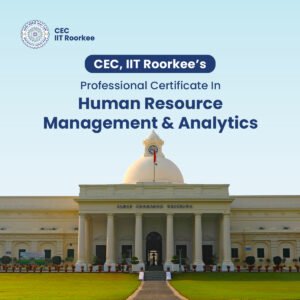Last updated on August 13th, 2024 at 09:14 am
Reading Time: 7 minutesThe modern HR landscape is undergoing a data-driven revolution. Despite the scope of human resource management increasing by the day, intuition and guesswork from pure experience are simply not enough in today’s time for hiring, project assignments, promotions/transfers etc. Organisations are now opting for more strategic approaches that leverage people analytics to optimise recruitment, retention and overall talent management.
Let us delve into the transformative power of data in HR and understand how data-driven strategies and analytics can empower organisations to build a high-performing workforce and achieve a sustainable competitive advantage.
People Analytics and Data-Driven HR for a Competitive Advantage
The tides are turning in the world of HR. Traditional, intuition-based decision-making is steadily giving way to a more strategic approach, one which is powered by the transformative potential of people analytics. This data-driven approach leverages a wealth of information about your workforce to optimise talent management across the entire employee lifecycle.
People analytics is more than just crunching numbers. It is about gathering and analysing a diverse set of data points, both quantitative (e.g., employee demographics, performance metrics, time-to-hire) and qualitative (e.g., employee surveys, exit interviews, feedback from performance reviews). This holistic view of your workforce empowers HR professionals to make informed decisions that not only benefit employees but also drive significant business outcomes.
Data-Driven Strategies for Increasing Recruitment Efficiency
Now that we have an idea of how data-driven strategies are different from traditional approaches, let us discuss the implementation of these strategic human resource management approaches.
Data-Driven Candidate Profiles for Hiring the Right Match
Gone are the days of generic job descriptions. Data analysis can be a powerful tool for crafting highly targeted candidate profiles. By analysing the skills, experience, and even personality traits of your top performers, you can identify the key factors that contribute to success within your organisation. This data-driven approach allows you to create targeted job descriptions and attract the best-fit candidates who are most likely to thrive in your specific environment.
Streamlining Your Hiring Funnel by Identifying and Eliminating Bottlenecks
A data-driven approach is not just about attracting the right talent, it is also about optimising the recruitment process itself. By analysing key metrics like time-to-hire, cost-per-hire, and application dropout rates, you can pinpoint bottlenecks and inefficiencies within your existing hiring funnel. Once you identify these trouble spots, you can implement data-driven solutions to streamline the process, reduce costs, and ensure faster hiring time for top talent.
Predictive Analytics for Forecasting Success and Hiring the Best
Data analysis can even help you predict future employee success. By leveraging historical data on hiring decisions and employee performance, organisations can develop scoring models or simulations. These tools can analyse a candidate’s skills, experience, and other relevant data points to predict their likelihood of success within your organisation.
This powerful form of predictive analytics allows you to prioritise candidates with the highest potential for long-term success, giving you a significant advantage in today’s competitive talent market. All of this further enhances the scope of human resource management in organisational structures and operations.
Data-Driven Strategies for Employee Retention
We covered how data-driven strategies are used for recruitment, now let us talk about how these strategic human resource management approaches help in employee retention.
Beyond the Exit Interview: Uncovering Employee Sentiment with Data
Employee retention is a critical aspect of building a successful organisation. But how do you know if your employees are truly satisfied and engaged? Data analysis offers valuable insights beyond traditional methods like exit interviews. By analysing data from employee surveys, social media platforms, and even sentiment analysis tools, HR can gauge overall employee sentiment and identify potential red flags that might indicate a risk of turnover. This allows for proactive intervention to address employee concerns before they reach a tipping point.
Retention Analytics: Predicting Flight Risk and Taking Action
Data analysis can be a powerful tool for predicting employee churn. By analysing historical data on employee turnover, performance reviews, and even external factors like market trends, HR can identify patterns and trends that signal potential flight risks. This allows us to focus our retention efforts on those employees who are most likely to leave, enabling us to implement targeted interventions to address their specific needs and concerns.
Tailored Engagement for a More Engaged Workforce
A one-sise-fits-all approach to employee engagement simply does not work. Data analysis can help HR personalise engagement initiatives for maximum impact. By analysing employee demographics, interests, and performance data, HR professionals can design targeted programs that cater to the specific needs and preferences of different employee groups. This data-driven approach fosters a more engaged and motivated workforce, ultimately leading to higher levels of productivity and retention.
If you are looking to equip yourself with the skills and knowledge to navigate this data-driven future of HR, consider Imarticus Learning’s Certification Program in Human Resource Management and Analytics with CEC, IIT Roorkee. This comprehensive HR analytics course equips HR professionals with the expertise to collect, analyse, and interpret data to make informed decisions that drive organisational success.
Empowering HR with Data-Driven Insights: Building a Strategic Advantage
Equipping your HR team with the power of data analytics unlocks a new level of strategic talent management. Here is how we can enhance the functions of human resource management with data:
Building a Data-Savvy HR Team
The foundation lies in fostering a data-driven culture within HR. Training HR professionals in data analysis skills empowers them to interpret complex data sets effectively. This allows them to translate insights into actionable strategies for recruitment, retention, and overall workforce development. Furthermore, effective communication skills become crucial. HR professionals need to translate data-driven insights into clear and concise language for stakeholders across the organisation, ensuring everyone understands the story behind the numbers.
Data Visualisation for Clear Communication
Complex data can often be overwhelming. Data visualisation tools can be a game-changer. By transforming raw data into charts, graphs, and other visual formats, HR can present insights in a clear and compelling way. This allows for better communication and facilitates informed decision-making across all levels of the organisation.
Ethical Considerations for Trust and Transparency
Data privacy regulations and ethical considerations are paramount. HR must ensure responsible data collection, storage, and usage practices. Transparency with employees regarding how their data is used is vital for building trust. By prioritising ethical data practices, HR maintains employee privacy while reaping the benefits of data-driven insights.

Industry-Specific Examples of Strategic Human Resource Management
Wondering about what is the scope of human resource management? Here are some industry-specific examples that show data in action and the scope of human resource management in relation to using data-driven strategies.
-
Retail Giant Optimises Scheduling with Predictive Analytics
A leading retail chain used historical sales data and customer traffic patterns to predict peak shopping hours. This data-driven approach allowed them to optimise employee scheduling, ensuring adequate staffing levels during busy periods and reducing labour costs during slower times. The result: improved customer service, reduced wait times, and a more engaged workforce due to predictable schedules.
-
Tech Startup Leverages Social Media to Find Top Talent
A fast-growing tech startup recognised the value of social media for talent acquisition. They used data analytics tools to identify potential candidates on platforms like LinkedIn and GitHub, targeting individuals with specific skills and experience relevant to their needs. This data-driven approach allowed them to source highly qualified talent and reduce reliance on traditional job boards, ultimately saving time and resources.
-
Financial Services Firm Personalises Engagement with Surveys and Analytics
A large financial services firm implemented employee engagement surveys and used data analytics to segment its workforce based on demographics, interests, and work styles. This allowed them to design targeted engagement programs that catered to the specific needs and preferences of different employee groups. The result is a significant increase in employee satisfaction and a reduction in voluntary turnover.
Data Analytics Tools and Techniques for HR
Here are some common data analytics tools and techniques that are used in various functions of human resource management in an organisation:
- Applicant Tracking Systems (ATS): Streamline the recruitment process by managing applications, scheduling interviews, and tracking candidate progress.
- Sentiment Analysis Tools: Analyse text data from employee surveys, social media, and emails to gauge employee sentiment and identify potential areas of concern.
- Employee Engagement Platforms: Provide a central hub for employee communication, feedback, and recognition programs. These platforms can also collect data on employee engagement levels and preferences.
- HR Analytics Dashboards: Offer a centralised view of key HR metrics, allowing HR professionals to monitor trends and make data-driven decisions.
The Future of HR Analytics and the Scope of Human Resource Management in the Modern Age
Wondering about what is the scope of human resource management in the future or what is the outlook for this domain with the arrival of AI-driven solutions? The future of HR analytics is brimming with potential. Artificial intelligence (AI) and machine learning are poised to revolutionise talent management even further. You can enrol in a solid HR analytics course to implement this data-driven approach with ease. Here is a glimpse of what is to come:
- AI-powered Chatbots for Recruitment: AI chatbots can screen resumes, answer candidate questions, and schedule interviews, freeing up HR professionals for more strategic tasks.
- Predictive Performance Analytics: Machine learning algorithms can analyse vast amounts of data to predict employee performance and identify potential high-potential employees.
- Personalised Learning and Development: AI-powered platforms can curate personalised learning paths for employees based on their skills, strengths, and weaknesses.
Wrapping Up
By embracing data-driven HR practices, organisations can unlock a wealth of insights into their workforce. These insights empower proactive talent management strategies, leading to a more engaged and productive work environment. By leveraging people analytics, HR professionals can also make informed decisions about talent acquisition, retention, and development, fostering a high-performing and engaged workforce that drives sustainable success.
Ready to harness the power of data to transform your HR practices? Enrol in the Certification Program in Human Resource Management and Analytics by Imarticus and IIT Roorkee to implement modern HR strategies in organisations such as the data-driven approach. The scope of human resource management is immense in today’s modern organisations. This HR analytics course will help you become invaluable in the world of talent acquisition and employee management.
Frequently Asked Questions
- How can data analytics help improve the recruitment process in HR?
Data helps identify ideal candidate profiles, streamline hiring funnels, and predict success, leading to faster and more effective recruitment.
- What are some ways data can be used to reduce employee turnover and improve retention?
By analyzing sentiment and identifying potential flight risks, HR can address concerns and create targeted engagement programs, fostering a happier and more engaged workforce.
- While data offers valuable insights, are there any ethical considerations HR professionals need to be aware of when using data analytics?
Responsible data collection, storage, and usage practices are crucial, along with maintaining transparency with employees about how their data is used.
- I’m interested in incorporating data-driven strategies in my HR department. What are some initial steps I can take to get started?
Training your HR team in data analysis, leveraging data visualization tools, and staying informed about AI and machine learning in HR are all great starting points

